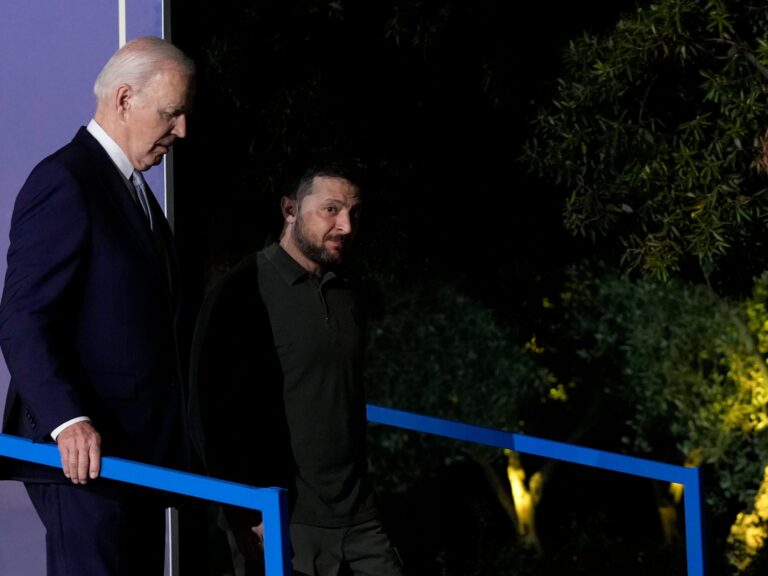The G7 group of countries announced a plan on Thursday to use frozen Russian assets to finance a $50 billion loan for Ukraine as kyiv continues its desperate campaign to prevent its neighbor’s larger forces from advancing further, 28 months after Moscow’s war began.
The announcement comes as leaders of the group, made up of the United States, United Kingdom, Germany, Italy, Canada, Japan, France and the European Union, met at an annual summit held in Puglia, Italy.
Ukrainian President Volodymr Zelenskyy, who attended the summit, hailed the move as “a vital step forward in providing lasting support to Ukraine in winning this war.”
But just hours after the announcement, Russian Foreign Ministry spokesperson Maria Zakharova promised that retaliatory measures would be “extremely painful.”
Here’s what we know about the frozen assets, how the loan should work, and what the risks could be for kyiv and its Western allies:
What are the frozen assets?
Many Western countries have frozen the Russian Central Bank’s assets on their territory after Russia’s invasion of Ukraine in 2022. These assets amount to around $300 billion. These frozen assets generated approximately $3 billion in annual interest income, and the United States has long insisted that this money be used to support Ukraine.
Most assets are owned and managed within the European Union.
EU officials say the interest generated is not contractually owed to Moscow and therefore represents windfall gains for the holding countries. Some have pushed for Russian assets frozen in the West to be handed over to Ukraine – but this is controversial and will likely require court authorization and could be a violation of international law. Frozen assets are generally considered to belong to their owner, not the country in which they are geographically located.
Where are Russian assets frozen?
Here is a breakdown of most Russian assets abroad that were initially frozen in 2022, according to data from the countries’ central banks:
- France ($71 billion)
- Japan ($58 billion)
- Germany ($55 billion)
- United States ($38 billion)
- United Kingdom ($26 billion)
- Austria ($17 billion)
- Canada ($16 billion)
How will the assets be used?
The details are still being discussed, but the basic idea is this: one of the G7 entities – the EU or the US, for example – will borrow $50 billion on the markets international and will immediately grant it to Ukraine.
Then, the interest on this loan will be financed by the profits generated by the confiscated Russian assets.
Ukraine should use this money to buy weapons, but also to rebuild. A World Bank report released in February estimated that the costs of rebuilding the war-ravaged country would amount to $486 billion over the next ten years.
When will Ukraine get this loan?
The funds are expected to reach kyiv by the end of the year. This means that it may not have an immediate effect on Ukraine’s capabilities in the ongoing war.
But the loan was always intended as a long-term plan. Some experts say U.S. President Joe Biden has pushed for this, even as he also sealed a new 10-year security plan to train Ukraine’s military, at a politically unstable time in the United States. Former President Donald Trump, who is ahead of Biden in key states heading into their next matchup in November, opposed U.S. funding for Ukraine.
During his first term, Trump withdrew the United States from major global commitments made by his predecessor, Barack Obama, including the Paris climate change pact and the Iran nuclear deal.
Are there any risks in the financing plan?
Yes. If Russia regains control of its assets, or if they are unfrozen as part of the peace negotiations, G7 countries will have to find other ways to repay the loan. If frozen Russian assets fail to generate the income needed to match the interest on the loan – due to market fluctuations – G7 countries will once again have to find other ways to finance loan repayment.
European Commission chief Ursula von der Leyen told reporters that all G7 countries would contribute to the loan, but the details are unclear.
Sanctions against Russian assets in Europe require an approval vote from the European Union each year. In theory, a single veto vote from, say, Hungary – an EU member widely seen as soft on Russian President Vladimir Putin – could sabotage Ukraine’s loan plans. Hungary blocked a tranche of EU aid to Ukraine earlier this year.
Russia could also retaliate against the G7 plan by doing the same, using Western assets in Russia that it froze during the war in Ukraine to compensate for lost revenue from its frozen assets in the West.
Although Russia does not have access to many assets of Western central banks, it claims to hold the assets of Western companies that operated there before the war. Russia says these assets are worth about the same as the $300 billion in Russian assets frozen in the West.


